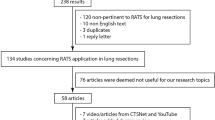Abstract
Background
Pleural empyema is an infectious disease of the chest cavity, with a high morbidity and mortality. According to the American Thoracic Society, pleural empyema gets graduated into three stages, with surgery being indicated in intermediate stage II and chronic stage III. Evidence for the feasibility of a minimally-invasive video-assisted thoracoscopic approach in stage III empyema for pulmonary decortication is still little.
Methods
Retrospective single-center analysis of patients conducted to surgery for chronic stage III pleural empyema from 05/2002 to 04/2014 either by video-assisted thoracoscopic surgery (VATS, n = 110) or conventional open surgery by thoracotomy (n = 107). Multiple regression analysis and propensity score matching was used to evaluate the influence of operation technique (thoracotomy versus VATS) on the length of post-operative hospitalization.
Results
Operation time was longer in the thoracotomy-group (p = 0.0207). Conversion rate from VATS to open surgery by thoracotomy was 4.5%. Post-operative complication- (61 patients in thoracotomy- and 55 patients in VATS-group), recurrence- (3 patients in thoracotomy- and 5 in VATS-group) and mortality-rates (6.5% in thoracotomy- and 9.5% in VATS-group) did not differ between both groups; the length of (post-operative) stay at intensive care unit was longer in the VATS-group (p = 0.0023). Duration of chest tube drainage and prolonged air leak rate were similar among both groups, leading to a similar overall and post-operative length of hospital stay in both groups. Adjusted to clinically and statistically relevant confounders, multiple regression analysis showed an influence of the surgical technique on length of post-operative stay after pair matching of the patients (n = 84 in each group) by propensity score (B = − 0.179 for thoracotomy = 0 and VATS = 1, p = 0.032) leading to a reduction of 0.836 days after a VATS-approach compared to thoracotomy.
Conclusions
VATS in late stage (III) pleural empyema is feasible and safe. The decrease in post-operative hospitalization demonstrated by adjusted multiple regression analysis may indicate the minimally-invasive approach being safe, more tolerable for patients, and more effective.
Similar content being viewed by others
References
Hamm H, Light RW (1997) Parapneumonic effusion and empyema. Eur Respir J 10:1150–1156
Andrews NC, Parker EF, Shaw RR, Wilson NJ, Webb WR (1962) Management of non tuberculous empyema: a statement of the subcommittee on surgery. Am Rev Respir Dis 85:935–936
Scarci M, Abah U, Solli P, Page A, Waller D, van Schil P, Melfi F, Schmid RA, Athanassiadi K, Sousa Uva M, Cardillo G (2015) EACTS expert consensus statement for surgical management of pleural empyema. Eur J Cardiothorac Surg 48:642–653
Reichert M, Steiner D, Kerber S, Bender J, Posentrup B, Hecker A, Bodner J (2016) A standardized technique of systematic mediastinal lymph node dissection by video-assisted thoracoscopic surgery (VATS) leads to a high rate of nodal upstaging in early-stage non-small cell lung cancer. Surg Endosc 30:1119–1125
Reichert M, Kerber S, Posentrup B, Bender J, Schneck E, Augustin F, Ofner D, Padberg W, Bodner J (2016) Anatomic lung resections for benign pulmonary diseases by video-assisted thoracoscopic surgery (VATS). Langenbecks Arch Surg 401:867–875
Dindo D, Demartines N, Clavien PA (2004) Classification of surgical complications: a new proposal with evaluation in a cohort of 6336 patients and results of a survey. Ann Surg 240:205–213
Reichert M, Hecker M, Witte B, Bodner J, Padberg W, Weigand MA, Hecker A (2016) Stage-directed therapy of pleural empyema. Langenbecks Arch Surg 402:15–26
Wait MA, Sharma S, Hohn J, Dal Nogare A (1997) A randomized trial of empyema therapy. Chest 111:1548–1551
Drain AJ, Ferguson JI, Sayeed R, Wilkinson S, Ritchie A (2007) Definitive management of advanced empyema by two-window video-assisted surgery. Asian Cardiovasc Thorac Ann 15:238–239
Waller DA, Rengarajan A (2001) Thoracoscopic decortication: a role for video-assisted surgery in chronic postpneumonic pleural empyema. Ann Thorac Surg 71:1813–1816
Chung JH, Lee SH, Kim KT, Jung JS, Son HS, Sun K (2014) Optimal timing of thoracoscopic drainage and decortication for empyema. Ann Thorac Surg 97:224–229
Schweigert M, Solymosi N, Dubecz A, Fernandez MJ, Stadlhuber RJ, Ofner D, Stein HJ (2016) Surgery for parapneumonic pleural empyema - What influence does the rising prevalence of multimorbidity and advanced age has on the current outcome? Surgeon 14:69–75
Stefani A, Aramini B, della Casa G, Ligabue G, Kaleci S, Casali C, Morandi U (2013) Preoperative predictors of successful surgical treatment in the management of parapneumonic empyema. Ann Thorac Surg 96:1812–1819
Lardinois D, Gock M, Pezzetta E, Buchli C, Rousson V, Furrer M, Ris HB (2005) Delayed referral and gram-negative organisms increase the conversion thoracotomy rate in patients undergoing video-assisted thoracoscopic surgery for empyema. Ann Thorac Surg 79:1851–1856
Petrakis IE, Kogerakis NE, Drositis IE, Lasithiotakis KG, Bouros D, Chalkiadakis GE (2004) Video-assisted thoracoscopic surgery for thoracic empyema: primarily, or after fibrinolytic therapy failure? Am J Surg 187:471–474
Cardillo G, Carleo F, Carbone L, Di Martino M, Salvadori L, Petrella L, Martelli M (2009) Chronic postpneumonic pleural empyema: comparative merits of thoracoscopic versus open decortication. Eur J Cardiothorac Surg 36:914–918
Chan DT, Sihoe AD, Chan S, Tsang DS, Fang B, Lee TW, Cheng LC (2007) Surgical treatment for empyema thoracis: is video-assisted thoracic surgery “better” than thoracotomy? Ann Thorac Surg 84:225–231
Tong BC, Hanna J, Toloza EM, Onaitis MW, D’Amico TA, Harpole DH, Burfeind WR (2010) Outcomes of video-assisted thoracoscopic decortication. Ann Thorac Surg 89:220–225
Author information
Authors and Affiliations
Corresponding author
Ethics declarations
Disclosures
Martin Reichert, Bernd Pösentrup, Andreas Hecker, Emmanuel Schneck, Jörn Pons-Kühnemann, Florian Augustin, Winfried Padberg, Dietmar Öfner, and Johannes Bodner have no conflicts of interest or financial ties to disclose.
Rights and permissions
About this article
Cite this article
Reichert, M., Pösentrup, B., Hecker, A. et al. Thoracotomy versus video-assisted thoracoscopic surgery (VATS) in stage III empyema—an analysis of 217 consecutive patients. Surg Endosc 32, 2664–2675 (2018). https://doi.org/10.1007/s00464-017-5961-7
Received:
Accepted:
Published:
Issue Date:
DOI: https://doi.org/10.1007/s00464-017-5961-7




